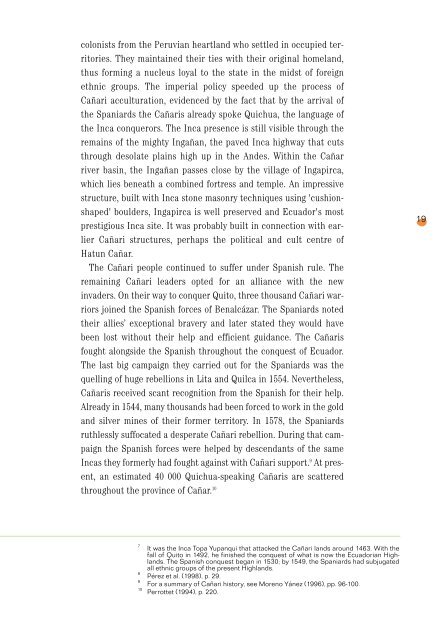mishqui-yacu, sweet water - IFAD
mishqui-yacu, sweet water - IFAD
mishqui-yacu, sweet water - IFAD
Create successful ePaper yourself
Turn your PDF publications into a flip-book with our unique Google optimized e-Paper software.
colonists from the Peruvian heartland who settled in occupied territories.<br />
They maintained their ties with their original homeland,<br />
thus forming a nucleus loyal to the state in the midst of foreign<br />
ethnic groups. The imperial policy speeded up the process of<br />
Cañari acculturation, evidenced by the fact that by the arrival of<br />
the Spaniards the Cañaris already spoke Quichua, the language of<br />
the Inca conquerors. The Inca presence is still visible through the<br />
remains of the mighty Ingañan, the paved Inca highway that cuts<br />
through desolate plains high up in the Andes. Within the Cañar<br />
river basin, the Ingañan passes close by the village of Ingapirca,<br />
which lies beneath a combined fortress and temple. An impressive<br />
structure, built with Inca stone masonry techniques using 'cushionshaped'<br />
boulders, Ingapirca is well preserved and Ecuador's most<br />
prestigious Inca site. It was probably built in connection with earlier<br />
Cañari structures, perhaps the political and cult centre of<br />
Hatun Cañar.<br />
The Cañari people continued to suffer under Spanish rule. The<br />
remaining Cañari leaders opted for an alliance with the new<br />
invaders. On their way to conquer Quito, three thousand Cañari warriors<br />
joined the Spanish forces of Benalcázar. The Spaniards noted<br />
their allies’ exceptional bravery and later stated they would have<br />
been lost without their help and efficient guidance. The Cañaris<br />
fought alongside the Spanish throughout the conquest of Ecuador.<br />
The last big campaign they carried out for the Spaniards was the<br />
quelling of huge rebellions in Lita and Quilca in 1554. Nevertheless,<br />
Cañaris received scant recognition from the Spanish for their help.<br />
Already in 1544, many thousands had been forced to work in the gold<br />
and silver mines of their former territory. In 1578, the Spaniards<br />
ruthlessly suffocated a desperate Cañari rebellion. During that campaign<br />
the Spanish forces were helped by descendants of the same<br />
Incas they formerly had fought against with Cañari support. 9 At present,<br />
an estimated 40 000 Quichua-speaking Cañaris are scattered<br />
throughout the province of Cañar. 10<br />
19<br />
7<br />
8<br />
9<br />
10<br />
It was the Inca Topa Yupanqui that attacked the Cañari lands around 1463. With the<br />
fall of Quito in 1492, he finished the conquest of what is now the Ecuadorian Highlands.<br />
The Spanish conquest began in 1530; by 1549, the Spaniards had subjugated<br />
all ethnic groups of the present Highlands.<br />
Pérez et al. (1998), p. 29.<br />
For a summary of Cañari history, see Moreno Yánez (1996), pp. 96-100.<br />
Perrottet (1994), p. 220.
















